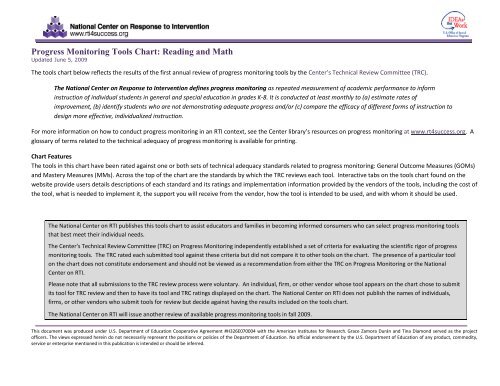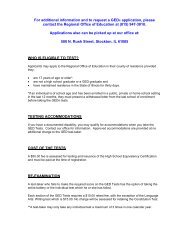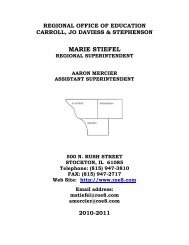Progress Monitoring Tools Chart: Reading and Math - REGIONAL ...
Progress Monitoring Tools Chart: Reading and Math - REGIONAL ...
Progress Monitoring Tools Chart: Reading and Math - REGIONAL ...
You also want an ePaper? Increase the reach of your titles
YUMPU automatically turns print PDFs into web optimized ePapers that Google loves.
<strong>Progress</strong> <strong>Monitoring</strong> <strong>Tools</strong> <strong>Chart</strong>: <strong>Reading</strong> <strong>and</strong> <strong>Math</strong><br />
Updated June 5, 2009<br />
The tools chart below reflects the results of the first annual review of progress monitoring tools by the Center’s Technical Review Committee (TRC).<br />
The National Center on Response to Intervention defines progress monitoring as repeated measurement of academic performance to inform<br />
instruction of individual students in general <strong>and</strong> special education in grades K-8. It is conducted at least monthly to (a) estimate rates of<br />
improvement, (b) identify students who are not demonstrating adequate progress <strong>and</strong>/or (c) compare the efficacy of different forms of instruction to<br />
design more effective, individualized instruction.<br />
For more information on how to conduct progress monitoring in an RTI context, see the Center library’s resources on progress monitoring at www.rt4success.org. A<br />
glossary of terms related to the technical adequacy of progress monitoring is available for printing.<br />
<strong>Chart</strong> Features<br />
The tools in this chart have been rated against one or both sets of technical adequacy st<strong>and</strong>ards related to progress monitoring: General Outcome Measures (GOMs)<br />
<strong>and</strong> Mastery Measures (MMs). Across the top of the chart are the st<strong>and</strong>ards by which the TRC reviews each tool. Interactive tabs on the tools chart found on the<br />
website provide users details descriptions of each st<strong>and</strong>ard <strong>and</strong> its ratings <strong>and</strong> implementation information provided by the vendors of the tools, including the cost of<br />
the tool, what is needed to implement it, the support you will receive from the vendor, how the tool is intended to be used, <strong>and</strong> with whom it should be used.<br />
The National Center on RTI publishes this tools chart to assist educators <strong>and</strong> families in becoming informed consumers who can select progress monitoring tools<br />
that best meet their individual needs.<br />
The Center's Technical Review Committee (TRC) on <strong>Progress</strong> <strong>Monitoring</strong> independently established a set of criteria for evaluating the scientific rigor of progress<br />
monitoring tools. The TRC rated each submitted tool against these criteria but did not compare it to other tools on the chart. The presence of a particular tool<br />
on the chart does not constitute endorsement <strong>and</strong> should not be viewed as a recommendation from either the TRC on <strong>Progress</strong> <strong>Monitoring</strong> or the National<br />
Center on RTI.<br />
Please note that all submissions to the TRC review process were voluntary. An individual, firm, or other vendor whose tool appears on the chart chose to submit<br />
its tool for TRC review <strong>and</strong> then to have its tool <strong>and</strong> TRC ratings displayed on the chart. The National Center on RTI does not publish the names of individuals,<br />
firms, or other vendors who submit tools for review but decide against having the results included on the tools chart.<br />
The National Center on RTI will issue another review of available progress monitoring tools in fall 2009.<br />
This document was produced under U.S. Department of Education Cooperative Agreement #H326E070004 with the American Institutes for Research. Grace Zamora Durán <strong>and</strong> Tina Diamond served as the project<br />
officers. The views expressed herein do not necessarily represent the positions or policies of the Department of Education. No official endorsement by the U.S. Department of Education of any product, commodity,<br />
service or enterprise mentioned in this publication is intended or should be inferred.
General Outcome Measures<br />
Tool Area<br />
Reliability of<br />
the<br />
Performance<br />
Level Score<br />
AIMSweb<br />
<strong>Math</strong><br />
Reliability of<br />
the Slope<br />
Validity of the<br />
Performance<br />
Level Score<br />
Predictive<br />
Validity of the<br />
Slope of<br />
Improvement<br />
Alternate<br />
Forms<br />
Sensitive to<br />
Student<br />
Improvement<br />
End-of-Year<br />
Benchmarks<br />
Rates of<br />
Improvement<br />
Specified<br />
Norms<br />
Disaggregated<br />
for Diverse<br />
Populations<br />
No<br />
Disaggregated<br />
Reliability <strong>and</strong><br />
Validity Data<br />
Oral <strong>Reading</strong><br />
No<br />
Test of Early Literacy –<br />
Letter Naming Fluency<br />
No<br />
Test of Early Literacy –<br />
Letter Sound Fluency<br />
No<br />
Test of Early Literacy –<br />
Nonsense Word Fluency<br />
No<br />
Test of Early Literacy –<br />
Phoneme Segmentation<br />
No<br />
Test of Early Numeracy -<br />
Missing Number<br />
No<br />
Test of Early Numeracy -<br />
Number ID<br />
No<br />
Test of Early Numeracy -<br />
Oral Counting<br />
No<br />
Curriculum<br />
Based<br />
Measurement<br />
in <strong>Reading</strong><br />
(CBM-R)<br />
Test of Early Numeracy -<br />
Quantity Discrimination<br />
Letter Sound Fluency<br />
Maze Fluency<br />
Passage <strong>Reading</strong> Fluency<br />
Word Identification Fluency<br />
No<br />
No<br />
No<br />
No<br />
No<br />
<strong>Chart</strong> Legend: Convincing Evidence | Partially Convincing Evidence or Convincing Indirect Evidence | Unconvincing Evidence | No Evidence Submitted<br />
This document was produced under U.S. Department of Education Cooperative Agreement #H326E070004 with the American Institutes for Research. Grace Zamora Durán <strong>and</strong> Tina Diamond served as the project<br />
officers. The views expressed herein do not necessarily represent the positions or policies of the Department of Education. No official endorsement by the U.S. Department of Education of any product, commodity,<br />
service or enterprise mentioned in this publication is intended or should be inferred.
General Outcome Measures Continues<br />
Tool Area<br />
Dynamic<br />
Indicators of<br />
Basic Early<br />
Literacy Skills<br />
(DIBELS)<br />
Initial Sound Fluency<br />
Nonsense Word Fluency<br />
Oral <strong>Reading</strong> Fluency<br />
Reliability of<br />
the<br />
Performance<br />
Level Score<br />
Reliability of<br />
the Slope<br />
Validity of the<br />
Performance<br />
Level Score<br />
Predictive<br />
Validity of the<br />
Slope of<br />
Improvement<br />
Alternate<br />
Forms<br />
Sensitive to<br />
Student<br />
Improvement<br />
End-of-Year<br />
Benchmarks<br />
Rates of<br />
Improvement<br />
Specified<br />
Norms<br />
Disaggregated<br />
for Diverse<br />
Populations<br />
No<br />
No<br />
No<br />
Disaggregated<br />
Reliability <strong>and</strong><br />
Validity Data<br />
Phoneme Segmentation<br />
Fluency<br />
No<br />
<strong>Monitoring</strong><br />
Basic Skills<br />
<strong>Progress</strong><br />
(MBSP)<br />
mCLASS:<br />
<strong>Math</strong><br />
Word Use Fluency<br />
Basic <strong>Math</strong> Computation<br />
Basic <strong>Math</strong> Concepts/<br />
Applications<br />
Computation<br />
Concepts<br />
Oral Counting<br />
Missing Number<br />
Next Number<br />
Number Facts<br />
Number Identification<br />
Quantity Discrimination<br />
No<br />
No<br />
No<br />
No<br />
No<br />
No<br />
No<br />
No<br />
No<br />
No<br />
No<br />
Scholastic <strong>Reading</strong> Inventory No<br />
STAR<br />
Early Literacy<br />
<strong>Math</strong><br />
No<br />
No<br />
<strong>Reading</strong><br />
<strong>Chart</strong> Legend: Convincing Evidence | Partially Convincing Evidence or Convincing Indirect Evidence | Unconvincing Evidence | No Evidence Submitted<br />
This document was produced under U.S. Department of Education Cooperative Agreement #H326E070004 with the American Institutes for Research. Grace Zamora Durán <strong>and</strong> Tina Diamond served as the project<br />
officers. The views expressed herein do not necessarily represent the positions or policies of the Department of Education. No official endorsement by the U.S. Department of Education of any product, commodity,<br />
service or enterprise mentioned in this publication is intended or should be inferred.<br />
No
General Outcome Measures Continues<br />
STEEP<br />
Tool<br />
Area<br />
Oral <strong>Reading</strong> Fluency<br />
Reliability of<br />
the<br />
Performance<br />
Level Score<br />
Reliability of<br />
the Slope<br />
Validity of the<br />
Performance<br />
Level Score<br />
Predictive<br />
Validity of the<br />
Slope of<br />
Improvement<br />
Alternate<br />
Forms<br />
Sensitive to<br />
Student<br />
Improvement<br />
End-of-Year<br />
Benchmarks<br />
Rates of<br />
Improvement<br />
Specified<br />
Norms<br />
Disaggregated<br />
for Diverse<br />
Populations<br />
No<br />
Disaggregated<br />
Reliability <strong>and</strong><br />
Validity Data<br />
Yearly<br />
<strong>Progress</strong> Pro<br />
<strong>Math</strong><br />
<strong>Reading</strong> Language Arts<br />
No<br />
No<br />
<strong>Reading</strong> Maze Fluency<br />
No<br />
<strong>Chart</strong> Legend: Convincing Evidence | Partially Convincing Evidence or Convincing Indirect Evidence | Unconvincing Evidence | No Evidence Submitted<br />
Mastery Measurement<br />
Tool<br />
Area<br />
Accelerated <strong>Math</strong><br />
<strong>Math</strong><br />
Skill Sequence<br />
Sensitive to Student<br />
Improvement<br />
Reliability<br />
Pass/Fail Decision<br />
Disaggregate<br />
Reliability <strong>and</strong> Validity<br />
Data<br />
<strong>Chart</strong> Legend: Convincing Evidence | Partially Convincing Evidence or Convincing Indirect Evidence | Unconvincing Evidence | No Evidence Submitted<br />
This document was produced under U.S. Department of Education Cooperative Agreement #H326E070004 with the American Institutes for Research. Grace Zamora Durán <strong>and</strong> Tina Diamond served as the project<br />
officers. The views expressed herein do not necessarily represent the positions or policies of the Department of Education. No official endorsement by the U.S. Department of Education of any product, commodity,<br />
service or enterprise mentioned in this publication is intended or should be inferred.










